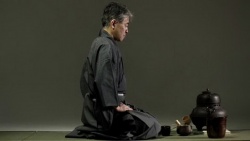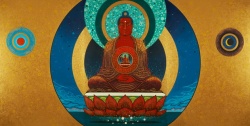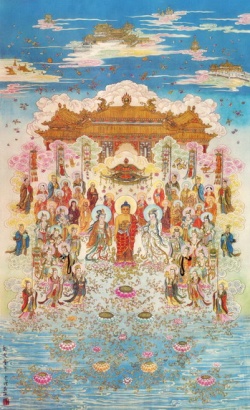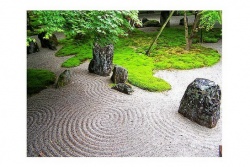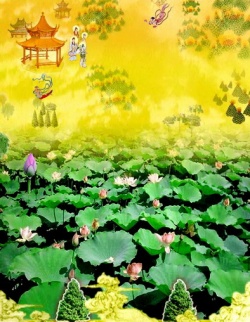The Dhyana-Samadhi Meditation Absorptions - Part 5
The Desire Realm Inhabitants, and Further Explanations of Joy and Bliss
Because we inhabit the Desire Realm, we experience a great desire for food and a desire for sexual relations, both of which tend to push us off the cultivation trail, and which we must surmount in the process of spiritual cultivation. Not only do these desires keep us bound in this lower Realm of Desire, but succumbing to them inevitably produces unpleasant results. For instance, sometimes you will eat a really good meal and feel very satisfied as a result of the joy of eating, but afterwards you may feel sick. Perhaps this is because you ate too much, or perhaps it is because you ate some spoiled food, or maybe you suffer from a particular food sensitivity.
Sexual relations may result in unpleasant reactions as well. What you are really after in these activities is the experience of joy and bliss, but you might actually end up feeling fatigued and disgusted. Eating delicious foods to satisfaction and enjoying sexual orgasm can be considered the happiness that ordinary individuals normally experience, but they cannot even touch upon the joy and bliss experienced in the meditative realms of the dhyana. Nevertheless, we need to employ these as analogies in order to help understand something of the cultivation joy and bliss of the dhyana.
Even the celestial beings of the Desire Realm seek joy and bliss, for all beings in the Desire Realm like to experience various kinds of enjoyment. As a general principle, all beings in the universe, whatever their realm or origin, all have the common goal of getting away from pain in order to experience joy. Practicing dharma to become a Buddha is a form of pursuing this goal as well, so to get away from pain to enjoy joy and bliss is a general principle found throughout the Three Realms.
The Realm of Desire contains six heavens that include (from lowest to highest) the:
(1) Four Deva Kings Heaven
(2) Trayastrimsha (Thirty-Three) Heaven
(3) Yama (Flame, or Free from Strife) Heaven
(4) Tushita (Joyous Land) Heaven
(5) Nirmanarati Heaven (Transformation Bliss)
(6) Paranirmata-Vasanda (Constant Pleasure) Heaven
In all these heavens, the male and female beings still retain a desire to enjoy food and sexual relations, though this desire can be either coarse, fine, narrow or broad in scope. Therefore, all six heavens of the Desire Realm retain a shadow of male and female sexual relationships. The degree of joy and bliss experienced in each heaven, however, is based upon a different merit reward that is reflected by the higher or lower status of that particular realm.
The inhabitants of these heavens also experience a joy derived from the senses (which perceive appearances, sounds, smells, tastes and so on) as we do, but once again these experiences are more refined than those found on earth. Thus, the heavenly beings of the Desire Realm have experiences similar to our own, but their stage of joy and bliss is stronger, higher, and of greater longevity than ours. Why? Because the merit of the heavenly beings is much higher than our own, and so their experiences are naturally better than ours are. This has nothing to do with whether they have Tao or not, for it is just a function of merit and their resultant stage of being.
In the Yama Heaven, above the Thirty-Three Heaven, the devas embrace each other in order to experience sexual joy and bliss. In the next higher heaven of Tushita, the inhabitants hold hands to experience sexual joy and bliss, while in the Nirmanarati Heaven they smile at one another. In the Paranirmata-Vasanda heaven, the devas need only look at one another to satisfy sexual desire and experience joy and bliss.
We can see that the levels of sexual bliss in the universe are therefore based on progressively finer factors: jing in our human world, chi in the lower Desire Realm heavens, and shen in the upper Desire Realm heavens. The eye contact that produces sexual satisfaction in the upper heavens is related to shen, since shen, or spirit, is connected with the eyes ("the window of the soul"). The gaze of lovers is just a slight reflection of this higher type of relationship, and when they lovingly hold hands or stroke each other, it is a shadowy reflection of the Tushita heaven.
This short explanation helps to explain why the samadhi of desire and joy espoused in Esoteric Buddhism is one of the cultivation methods used by heavenly beings in the Desire Realm. Sexual cultivation is not the highest method for practicing dharma because it can only take you to the top of the Desire Realm heavens. Nevertheless, if you have the requisite prajna wisdom, merits and foundation of attainments, you can make it into a genuine cultivation technique. A detailed discussion of this matter, however, would require an elaborate book involving all sorts of other factors like medicine, physiology, and psychology.
In this discussion we do not mention the joy and bliss experienced by animals, hungry ghosts and hell beings because these groups, and the last two in particular, experience very little joy and bliss. So the only reason we mention sexual relations is to link knowledge of this form of bliss with the joy and bliss attained in the first dhyana, and to note that the beings in the Desire Realm heavens try to use the bliss of sexual contact, in conjunction with emptiness meditation, in order to try and jump out of the Desire Realm and attain Buddhahood. But if your mind is not empty during this type of practice and you still retain sexual desires--because you have not attained samadhi and transformed your chi mai--this type of practice can produce major impediments on the cultivation path.
The main characteristics of the first dhyana are one-pointed concentration, and becoming mentally freed from the body and mind to attain mental joy and physical blissfulness. This stage of joy and bliss is already above that normally found in the Desire Realm, for it is a stage only experienced within the Realm of Form. When in Esoteric Buddhism we talk about the chi entering the central channel so as to produce samadhi realms of joy and bliss, we divide these experiences into four categories that correspond to each of the four dhyana: (1) bliss, (2) supreme bliss, (3) extraordinary bliss, and (4) innate (simultaneous) bliss.
In Esoteric Buddhism, you also have a Supreme Bliss Heruka, whose name indicates that what is being represented is one of the stages of cultivation. Esoteric Buddhism also talks about the "four empties," which are matched up with the "four blisses" of cultivation. All it is doing when it describes things in this way is take the first four dhyana and explain their characteristics in terms of the individual components of esoteric biophysics. Of course, no one in the Tibetan school will explain this to you, so if you do not study widely enough to connect all the parts, these issues will pass you by and what you have already learned will go to waste.
In the first dhyana, to become freed of the strictures of body and mind is so joyful that you will feel like you are outside of this world. Thus, to be reborn in the upper realms not only requires merit, but requires that you master the particular samadhi or dhyana that accord with these higher regions. One of the motivations for some cultivation practitioners is that they so dislike this world of suffering that they want to escape, and in the first dhyana you can finally start making some progress towards this goal of escaping from the lower realms.
The first dhyana enables you to achieve some degree of freedom from worldly feelings, and promises rebirth in a higher realm after you die. In fact, when people first start to cultivate they are encouraged to contemplate four great truths that help to generate detachment from worldly phenomena and thus speed them on their way to attaining the various dhyana. These great truths all recognize the impurity of the world, and in particular that:
(1) the physical body is dirty and impure
(2) all conditioned states are painful; all sensations end in suffering
(3) all things are impermanent
(4) all phenomena have no self-nature; that is, all phenomena are empty, and there is no such thing as an inherent self or ego
From the fundamental point of view you can say that everything is clean, but from the world of phenomena you can say that everything is dirty. However, since from the fundamental standpoint the heavens in the Formless Realm are crude, and from the Realm of Desire we can say they are very pure, you can see that this is just a relative way of looking at matters.
After you attain the first dhyana, the question is how to rise above the joy and bliss of the Desire Realm to attain the stages of "supreme" and "extraordinary" joy and bliss mentioned in the Esoteric school, and which corresponds to attainment levels past the first dhyana. Can you even describe the difference between the pleasurable joy and bliss of the Desire Realm and the higher states of joy and bliss experienced in the Realms of Form and Formlessness?
Because even learned cultivators cannot do so, Buddhism uses the terms "joy and bliss" only as a way to roughly indicate the nature of these exceptional experiential states. Therefore, you should not get too attached to these words and ascribe too many definite characteristics to them. All we can say clearly in regards to the higher realms of Form and Formlessness is that their joy and bliss are already above those of the worlds in the Desire Realm. In the state of supreme clarity and calm, there is no joy and bliss whatsoever since they are dissolved in equanimity. When you reach dhyana, we summarize matters to an extreme by simply saying that you attain an experiential realm that involves clarity and calm, joy and bliss.
The Pre-Samadhi State of Ching-An
There is also a preliminary form of initiatory joy and bliss, called ching-an, or "lightness and calm," which is experienced by meditators before they attain a stable stage of samadhi. It is experienced when they first begin to open their energy channels. In Christian mysticism, this is the stage referred to as the "washing of the feet" since when it originates from the heels, the feet feel as if they were being bathed in a cool wind, or cool vapor of soft air. Naturally this state is different from sexual joy and bliss, and is an important stage cultivators will pass through on their way to attaining samadhi.
As Tao and Longevity comments to explain this state:
When restlessness and torpor both disappear, and the mind suddenly fixes on a single thing in the absence of sleep and restlessness, then lightness occurs. For some, this sensation begins at the top of the head, whereas for others it originates in the soles of the feet.
When lightness begins at the top of the head, the top of the head feels fresh and cool as if cream were being gently poured over it [see Hakuin's duck egg Soma Cream meditation). The Buddhists and Taoists call this "internal baptism." [This is a real empowerment) This sensation circulates around the entire body, the mind is rested, the body is relaxed, and one feels so soft and flexible that it often seems as if the bones themselves have dissolved. It is then natural for the body to become straight as a pine tree. The mind is clear and there are no feelings of restlessness or torpor in response to external surroundings. One experiences a natural state of joy. This experience of lightness, however, eventually disappears.
When lightness originates in the soles of the feet, one experiences sensations of either coolness or warmth, which move upward to the top of the head. It often feels as if this lightness moves beyond physical boundaries to penetrate the sky. The lightness that originates from the soles is much easier to retain than the lightness that originates at the top of the head. It does not disappear quite so easily.
Confucianists say that a person has the sense of spring when he has attained a state of quietude. Spring indicates feelings of warmth, growth, freshness, and joy. These feelings accompany experiences of lightness during meditation.
Lightness gradually fades when one is forced to deal with mundane affairs and cannot sustain his efforts to progress further. Thus, if possible, it is often best for a person who has reached this state to live alone in a quiet place.
Oftentimes one who continues to cultivate will notice that this phenomenon of lightness grows weak, but this does not mean that it actually fades away. On the contrary, if one remains in this state for a long while, the sensation of lightness will not appear to be as strong as it was at the beginning. It is very much like eating new food for the first time. In the beginning the taste is intensely fresh, but the continual eating of this same food day after day dulls the flavor and it will not appear to be nearly so refreshing as it was initially.
If one continues to maintain the state of lightness without interruption, then one's samadhi will become firm and stable. One will feel calm and clear. The ch'i channels throughout the entire body will undergo various changes, and the body will feel warm and harmonious and as if one is experiencing a strong internal orgasm. These feelings are difficult to describe but the Chinese often say that one is "internally touched by wonderful pleasures." A person can detach himself from worldly desires only by progressing to this point.
We describe the stage of ching-an as a state of lightness and coolness since the general sensation is similar to dry ice vapor or air conditioning lightly pouring over the length of the physical body. When a practitioner attains this state, they must be careful not to have too much desire for this scenario because of its pleasant nature, for the desire is considered a violation of spiritual discipline, and will actually impede the transformation of ching-an into samadhi. Ching-an, like all the stages of attainment, has its own different levels, and can be either great or small.
Tsong Khapa, in his Great Exposition of the Stages of the Path, mentioned there are two major types of pre-samadhi ching-an which can occur. The first type is when the coolness starts from the top of the head and descends towards the bottom of the feet. The second type is when the coolness starts at the bottom of the feet, and then ascends upwards to the top of the head.
Of these two types, the least stable one, or easiest one to lose, originates from the top of the head (the Hakuin duck egg meditation helps engender this state). However, if ching-an is initiated from the feet then it is much harder to lose. On this point we must remember that Buddhism stresses the big toes and the soles of the feet in cultivation, the long-lived Immortals emphasize having the chi reach the bottom of the feet, the skeleton meditation must be started from the feet and work upwards, and Taoism emphasizes that the true man "breathes from his heels."
During the first appearance of ching-an, the pituitary gland will secrete a sweet-tasting hormone that can extend your longevity. This is the famous "ambrosia" of the Greeks, "soma" of the Vedas, "grail wine" of the Medieval Christian mystics, "madya" (divine wine) of the Tantras, "sweet wine" of the Sufis, or "amrita" known in countless cultivation schools. For example, the Vedic Svetasavatar Upanishad of Hinduism refers to this state when it says, "Where the fire (agni) is enkindled, where the breath (vayu) is controlled, where the nectar (soma) overflows, there the Mind is born." This sentence refers to the transformation of jing into chi wherein the breathing stops (accordingly generating the state of hsi, or agni), the pituitary hormones are being secreted (soma), and samadhi ("the Mind") is about to be realized (born).
Taoism has many descriptions of this "dew" or "sweet nectar" descending, and in the European grail legends and medieval alchemy books we can find this same phenomenon referred to in abundance. If we wanted to search out an even more obscure cultivation school to demonstrate the universal nature of this stage, we can look to Alexandrine Gnosticism.
In the school of Alexandrine Gnosticism, we have the perfect man, or cultivation practitioner, who descends into the Virgin's womb (the region of the tan-tien), removes the impurity contaminating the firstborn of water (the jing essence is purified and transforms into chi), washes himself (the tu mai and jen mai open so that chi can circulate over the body) and drinks from the living waters (the hormones, such as this sweet pituitary gland secretion, descend). Thus, no matter how the various cultures of the world disguise their descriptions of the common cultivation stages, when you know the relevant kung-fu you can understand everything at one glance.
Of course, these are just descriptions of small ching-an, the state of "ease and peace" which is the pre-cursor to samadhi. In Taoist terms, it corresponds to the opening of the jen mai and tu mai channels, and in yoga or Esoteric Buddhism it corresponds to the opening of the left and right channels. At this point you must be careful not to lose this stage out of laziness, which might prompt you to meditate less, and you should strive at all costs from letting your jing leak away through sexual activity. This is a period for celibacy and sexual restraint. Nevertheless, small ching-an is still small ching-an whereas the great ching-an is harder to attain, and is much superior.
In great ching-an the body feels clear, soft and light, which means you are already at the stage of cultivating the chi, mai and tumo fire. From another aspect, we can say that the great ching-an corresponds to opening the central channel, but even the Esoteric school does not like to say this because people resultantly get attached to this idea, and then get entangled in all sorts of false expectations and in pursuing forced meditation methods to achieve this result. In actuality, if we wanted to be really accurate, we would have to say that the real great ching-an corresponds to the stage of complete enlightenment, so you cannot take the discussion of this matter too lightly.
To attain the first dhyana, one's kundalini, chakras, chi, mai, etc. must already be open and operative, otherwise you would not be able to experience the joy and bliss of dhyana. Therefore, in reaching the first dhyana we can say that the cultivation practitioner succeeds a bit in abandoning their view of being or possessing a body. Even ordinary people can do this at times, for you might forget your body when you get into a fist fight. However, the difference between forgetting your body during a fight and forgetting the body at the level of the first dhyana is really a prajna achievement, just as the difference between the samadhi of a scientist or athlete, and an enlightened master's samadhi, is due to the existence, or lack of, prajna transcendental wisdom.
You can try to relate the event of achieving the first dhyana to the first and second skandhas, but this is very difficult because you cannot make any sort of correlation with exactness. For instance, when you are liberated from the form and sensation skandhas, can you definitely say you have liberated yourself from the view of possessing a body? The answer is no! And why? Because the root of the view of the body lies within the seventh consciousness, so if you have not freed yourself from the five skandhas to a major degree, you cannot get rid of the view of the body in entirety. To really get rid of the view of the body is very difficult indeed, which is why Lao Tzu said it bothered him so much.
How about matching up the first dhyana with the Taoist transformation sequence of jing, chi and shen? Here we can say that to achieve the first dhyana you must not let the jing leak away by succumbing to sexual desire. Otherwise, you will not be able to transform your jing into chi. The biological bliss you experience at this point can occur because your jing becomes full (through no-leakage) and then descends. At this point, the ching-se in all your cells becomes activated, which is why you can experience physical bliss. Another way of putting it is to say that since you are transforming your body into ching-se, you will naturally experience joy and bliss.
In addition to all this, to reach the stage of the first dhyana you must have already opened up the body's chi channels, otherwise you could not achieve the necessary state of mental unity and calm. Therefore, to be able to reach the first dhyana, you must at least have reached the stage of cultivation such that your jing has transformed into chi. When the chi reaches the brain your thoughts will be lessened, so the stage of the first dhyana will require chi cultivation in some measure. This does not mean you have to force your chi to do something, but simply means that you must reach the stage where your jing transforms into chi naturally.
Many people today casually talk about Mahayana and Hinayana cultivation, but hardly anyone understands all these interrelationships, nor has even achieved the authentic first dhyana. To do so, you need both prajna wisdom and merit. Basically, to achieve the first dhyana you must achieve the mental attainment of transforming the root afflictions, so achieving the first dhyana is not the result of simply cultivating the physical body.
As we saw, Lady Tsogyel underwent many tests to see if she had really transformed the poisonous habits of her mind. Milarepa, Gampopa, and Yeshe Tsogyel were all successful in achieving the first stage of dhyana, but they all went through much pain and suffering before they attained their higher samadhi. Thus, you should not think that you can attain the first dhyana without any trouble, or that it is so easy. That is why there is the Zen poem:
Above the valley lies a blanket of white clouds
The birds returning to their nests become lost.
Occasionally you might be able to experience the ching-an state of lightness and peace, but the real difficulty is to maintain it at all times with mindfulness so that it develops into the first dhyana. Once you reach any stage of cultivation accomplishment, discipline means that you do not lose that stage of attainment. You do not cling to it with attachment but rather, you maintain it with mindfulness until it transforms into a yet higher stage of attainment.
